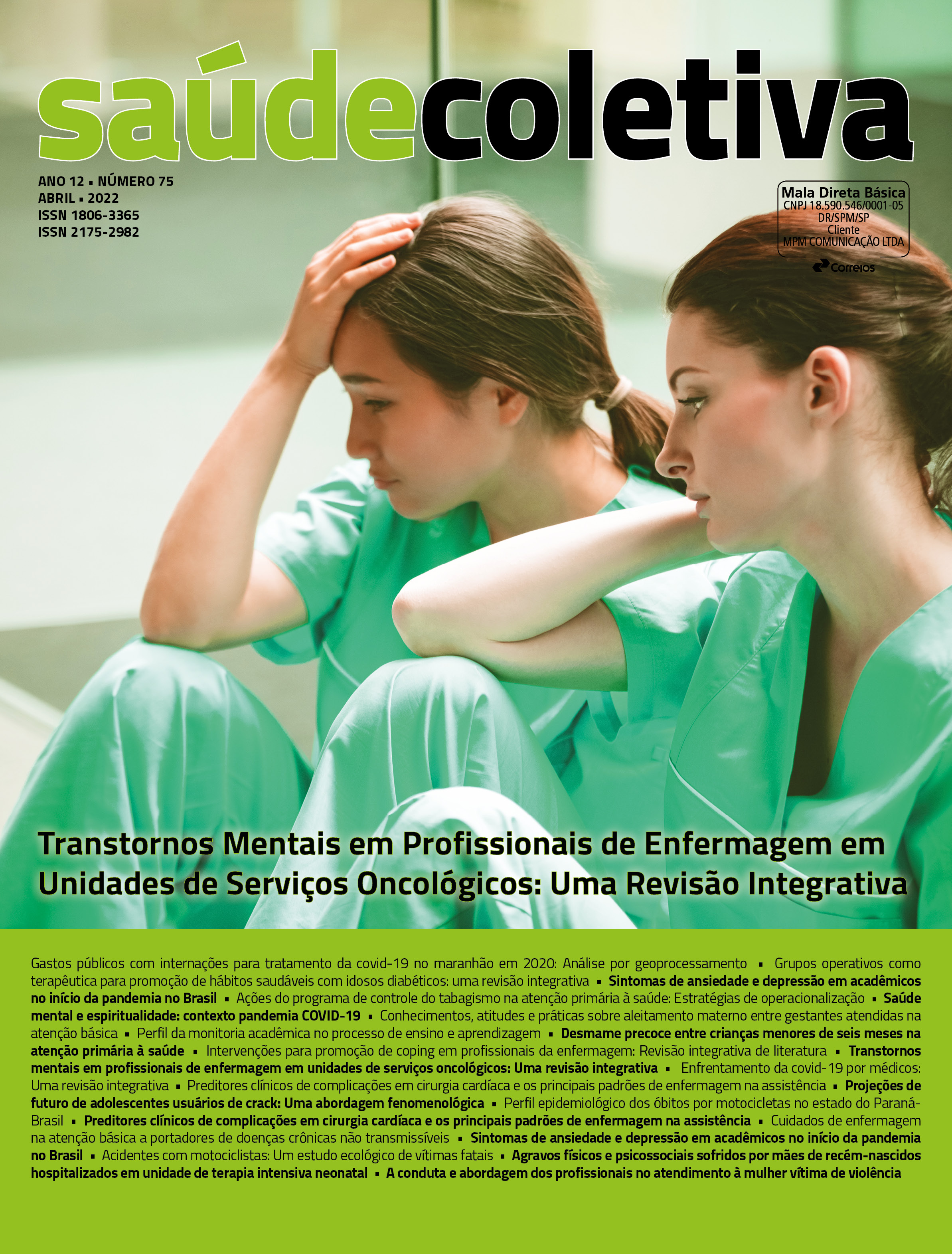Projections for the future of adolescent crack users: A phenomenological
DOI:
https://doi.org/10.36489/saudecoletiva.2022v12i75p10213-10222Keywords:
Adolescent, Drug users, Substance related disorders, Crack, NursingAbstract
Objective: To know the future projections of adolescent crack users assisted at the Psychosocial Care Center. Method: Qualitative research carried out with 13 adolescents assisted at a Psychosocial Care Center for users of alcohol and other drugs, in a city in southern Brazil, during the second semester of 2016. An interview and Comprehensive Analysis of the data was carried out from the framework of Schütz's Social Phenomenology. Results: As the future projections reported: resisting the influence of the drug and staying in treatment; rescue oneself and (re)build family and social relationships; resuming studies and (re)entering work; live a little longer. Conclusion: The “reasons for” the social behaviors of teenage crack users undergoing treatment reveal a fragile adolescence, but with the potential to project the transformation of their “lifeworld”. By understanding the adolescents' individualities, the multidisciplinary team can build a unique therapeutic project.
References
World Health Organization. Definition of keyterms Consolidated ARV guidelines. June 2013. Disponível em: <http://www.who.int/topics/adolescent_health/es/>.
Respress BN, Small E, Francis SA, Cordova D. The Role of Perceived Peer Prejudice and Teacher Discrimination on Adolescent Substance Use: A Social Determinants Approach. J Ethn Subst Abuse [Internet]. 2013;12(4):279-99. Disponível em: https://www.ncbi.nlm.nih.gov/pmc/articles/PMC3878308.
Chakravarthy B, Shah S, Lotfipour S. Adolescent drug abuse - Awareness & prevention. Indian J Med Res[Internet]. 2013 Jun; 137(6): 1021 1023. Disponível em: https://www.ncbi.nlm.nih.gov/pmc/articles/PMC3734705.
Brasil. Secretaria Nacional de Políticas sobre Drogas (SENAD), Fundação Oswaldo Cruz (FIOCRUZ.) Perfil dos usuários de crack e/ou similares no Brasil Inquérito epidemiológico. 2013. Disponível em: http://www.crianca.mppr.mp.br/arquivos/File/publi/senad/senad_pesq_crack_total_17set2013.pdf.015.pdf.
Francelino AG, Quinderé PHD, Rimes TS, Andrade AT, Costa LSP, Morais SSF. Compreensões de estudantes e professores de uma escola pública de ensino fundamental sobre uso de crack na adolescência. Saúde coletiva [Internet]. 2021;11(62):5038-5043. Disponível em: http://www.revistas.mpmcomunicacao.com.br/index.php/saudecoletiva/article/view/980.
SAMHSA, U.S. Department of Health and Human Services (HHS). Key Substance Use and Mental Health Indicators in the United States: Results from the 2015 National Survey on Drug Use and Health. September 2016. Disponível em: https://www.samhsa.gov/data/sites/default/files/NSDUH-DetTabs-2015/NSDUH-DetTabs-2015/NSDUH-DetTabs-26.
Martins MM, Souza J, Silva AA. Children and adolescents who are substance users in the psychiatric emergency service. Acta Paul Enferm [Internet]. 28(1):13-8. Disponível em: http://www.scielo.br/pdf/ape/v28n1/1982-0194-ape-028-001-0013.pdf.
Persaud S, Tzemis D, Kuo M, Bungay V, Buxton JA. Controlling chaos: the perceptions of long- term crack cocaine sers in vancouver, british columbia, Canada. J Addict[Internet]. 201; Article ID 851840, 9 pages. Disponível em: https://www.hindawi.com/journals/jad/2013/851840.
Johnson BA, Ait-Daoud N, Wang XQ, Penberthy JK, Javors MA, Seneviratne C, et al. Topiramate for the Treatment of Cocaine Addiction A Randomized Clinical Trial. JAMA Psychiatry[Internet]. 2013; 70(12):1338-46. Disponível em: https://www.ncbi.nlm.nih.gov/pubmed/24132249.
Schütz A. El problema de la realidade social. Buenos Aires: Amorrortu; 2008
Schütz A, Luckmann T. Las estructuras del mundo de la vida. Buenos Aires: Amorrortu, 2009.
Martins J, Bicudo MAV. A pesquisa qualitativa em Psicologia: fundamentos e recursos básicos. São Paulo: Centauro, 2011.
Lopes GM, Nobrega BA, Del Prette G, Scivoletto S. Use of psychoactive substances by adolescents: current panorama. Rev. Bras. Psiquiatr. [Internet]. 2013; 35(Suppl 1): S51-S61. Disponível em: http://www.scielo.br/scielo.php?script=sci_arttext&pid=S1516-44462013000500007&lng=en
Maremmani I, Cibin M, Pani PP, Rossi A, Turchetti G. Harm Reduction as “ContinuumCare” in Alcohol Abuse Disorder. Tchounwou P, ed. International Journal of Environmental Researchand Public Health. 2015 nov;12(11):14828-14841.
Seleghim MR, Oliveira MLF. Influence of the family environment on individuals who use crack Acta Paul Enferm[Internet]. 2013; 26(3):263-8. Disponível em: http://www.scielo.br/pdf/ape/v26n3/10.pdf.
Henriques BD, Rocha RL, Reinaldo AMS. Use of crack and other drugs among children and adolescents and its impact on the family environment: an integrative literature review. Texto Contexto Enferm[Internet], 2016; 25(3):e1100015. Disponível em: http://www.scielo.br/pdf/tce/v25n3/pt_0104-0707-tce-25-03-1100015.pdf.







